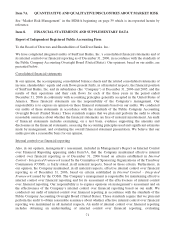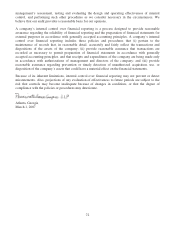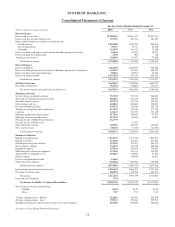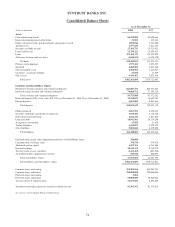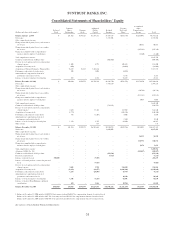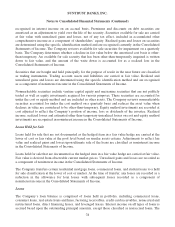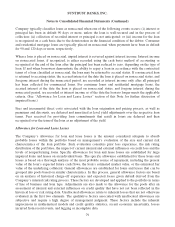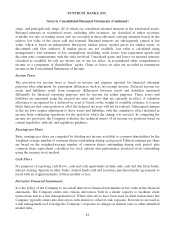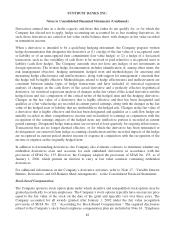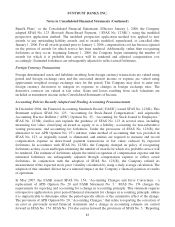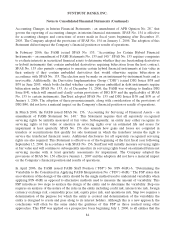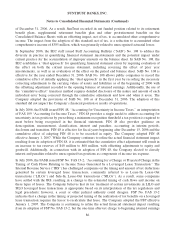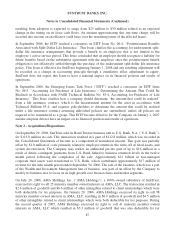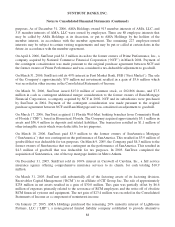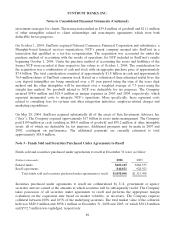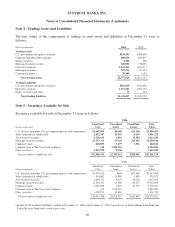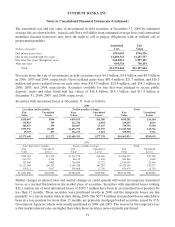SunTrust 2006 Annual Report Download - page 94
Download and view the complete annual report
Please find page 94 of the 2006 SunTrust annual report below. You can navigate through the pages in the report by either clicking on the pages listed below, or by using the keyword search tool below to find specific information within the annual report.SUNTRUST BANKS, INC.
Notes to Consolidated Financial Statements (Continued)
strips, and principal-only strips, all of which are considered retained interests in the transferred assets.
Retained interests in securitized assets, including debt securities, are classified as either securities
available for sale or trading assets and are recorded at their allocated carrying amounts based on the
relative fair value of the assets sold and retained. Retained interests are subsequently carried at fair
value, which is based on independent, third-party market prices, market prices for similar assets, or
discounted cash flow analyses. If market prices are not available, fair value is calculated using
management’s best estimates of key assumptions, including credit losses, loan repayment speeds and
discount rates commensurate with the risks involved. Unrealized gains and losses on retained interests
classified as available for sale are shown, net of any tax effect, in accumulated other comprehensive
income as a component of shareholders’ equity. Gains or losses on sales are recorded in noninterest
income in the Consolidated Statements of Income.
Income Taxes
The provision for income taxes is based on income and expense reported for financial statement
purposes after adjustment for permanent differences such as tax-exempt income. Deferred income tax
assets and liabilities result from temporary differences between assets and liabilities measured
differently for financial reporting purposes and for income tax return purposes. These assets and
liabilities are measured using the enacted tax rates and laws that are currently in effect. A valuation
allowance is recognized for a deferred tax asset if, based on the weight of available evidence, it is more
likely than not that some portion or all of the deferred tax asset will not be realized. Subsequent changes
in the tax laws require adjustment to these assets and liabilities with the cumulative effect included in
income from continuing operations for the period in which the change was enacted. In computing the
income tax provision, the Company evaluates the technical merits of its income tax positions based on
current legislative, judicial, and regulatory guidance.
Earnings per Share
Basic earnings per share are computed by dividing net income available to common shareholders by the
weighted-average number of common shares outstanding during each period. Diluted earnings per share
are based on the weighted-average number of common shares outstanding during each period, plus
common share equivalents calculated for stock options and performance restricted stock outstanding
using the treasury stock method.
Cash Flows
For purposes of reporting cash flows, cash and cash equivalents include only cash and due from banks,
interest-bearing deposits in other banks, federal funds sold and securities purchased under agreements to
resell with an original maturity of three months or less.
Derivative Financial Instruments
It is the policy of the Company to record all derivative financial instruments at fair value in the financial
statements. The Company enters into various derivatives both in a dealer capacity to facilitate client
transactions and as a risk management tool. Where derivatives have been used in client transactions, the
Company typically enters into derivatives with dealers to offset its risk exposure. Derivatives are used as
a risk management tool to hedge the Company’s exposure to changes in interest rates or other identified
market risks.
81


